British Medical Casualties on the Western Front : Wound Induced Trauma Related to Technological Advances in War
- Home
- World War I Articles
- British Medical Casualties on the Western Front : Wound Induced Trauma Related to Technological Advances in War
British Medical Casualties on the Western Front in the Great War Part 2:
Wound Induced Trauma Related to Technological Advances in War by Dr David Payne
Introduction
It has been said that the infantry soldier of the British Expeditionary Force (BEF) went to war on the Western Front dressed and armed like a game-keeper from an English or Scottish landed estate and there is more than a little truth in this. Meanwhile, in line with this low technology approach to war, the British medical authorities assumed the vast majority of battle wounds would be due to rifle bullets and shrapnel balls from shrapnel shells, as they had been for over 100 years. However, this quickly changed as new technological advances engendered by war altered the face of warfare from the small-scale open and mobile war of autumn 1914 to the hugely extensive subterranean and static trench war from the winter of 1914 onwards. Inevitably, these changes brought with them a whole new complex of war traumas that had to be dealt with on and off the battlefield.
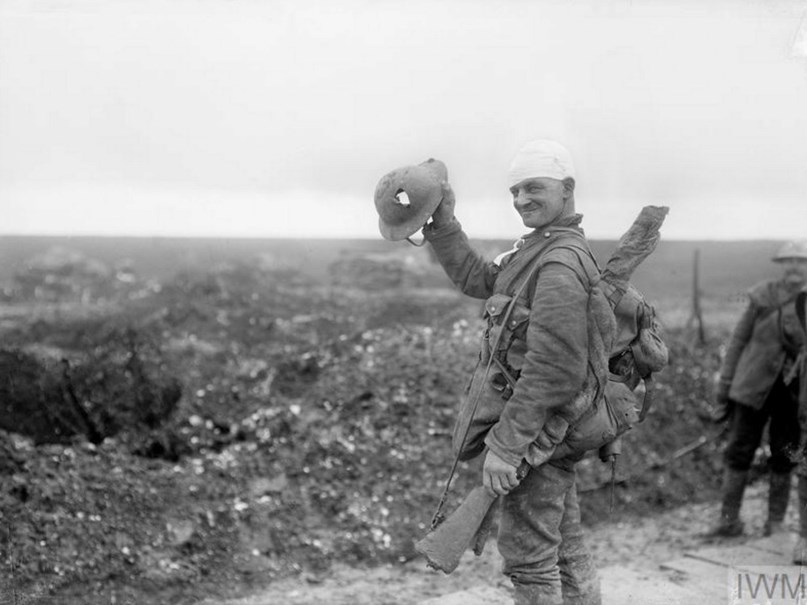
Wounded British soldier holding his steel helmet which has been pierced by a piece of shrapnel during the advance on the Somme front near Hamel. © IWM (Q 1778)
The Battle Bowler
Perhaps the first really significant piece of entirely new and personal military technology was the introduction of the steel helmet. This rather obvious requirement was forced upon all the belligerent nations by the heavy casualty numbers arising from head, face and neck wounds. These rose from 10 per cent to 20 per cent after the armies went to ground in trench warfare in 1914. The French were the first to have a standardissue steel helmet in late 1915 with their rather stylish Adrian multi-component M1915 helmet. Although one senior French medical adviser complained that the introduction of the helmet wasill-advised asit extended the survival time of those wounded in the head and neck and clogged up the casualty clearance system! Itsintroduction was closely followed by the British Brodie helmet, and by mid-1916, the German M1916 Stahlhelm was on general issue. The British Brodie was made of forged manganese steel plate whilst the other two were stamped from steel plate; the French of mild steel, the German of chrome/nickel. The main weakness of the British helmet was that it offered little lateral protection to the neck and the face but, nonetheless, with slight modifications, it survived to see service throughout the Second World War, as did the German ‘coal scuttle.’ (The reinforced rim of the British steel helmet also enabled its use as a formidable weapon in hand-to-hand fighting).
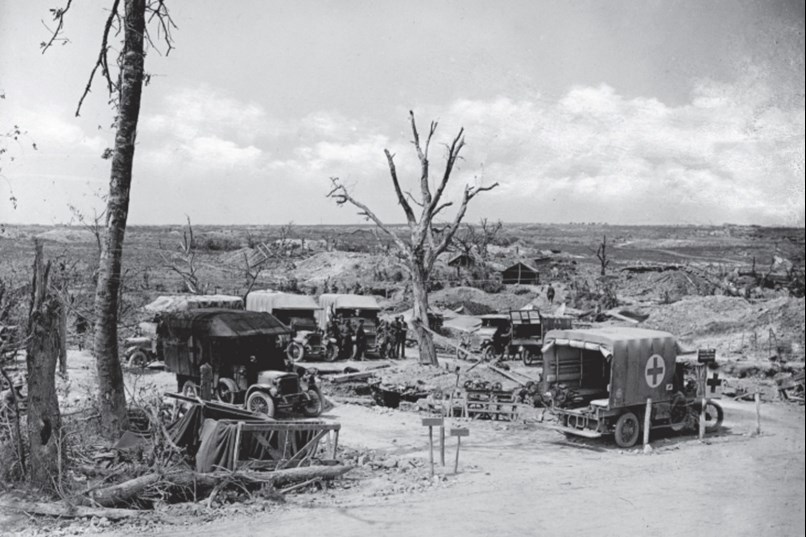
A dressing station set up near Fricourt during the battle of Pozières Ridge. The ambulance on the right bears the fern leaf insignia of the New Zealand Division next to the cab door. IWM Q 4086.
The Machine Gun
Various national and international models of the heavy field machine gun were already in service with the infantry regiments of the belligerent nations at the outbreak of war. But, in 1914, the overall level of provision in the British and French Armies on the Western Front was significantly lower than the German Army’s 12,000. (The British Army’s machine gun strength rose from a few hundred in 1914 to over 100,000 in 1918). Its efficacy wassoon apparent once wide-scale operations developed, but its utility as a weapon of defence was particularly manifest when trench warfare became widespread from the end of 1914 onwards; whole divisions of attacking troops were reduced by its killing power. The increasing use of the machine gun vastly increased the numbers of wounded receiving multiple wounds. Casualties were often recovered from the battle field with multiple wounds to the limbs, abdomen, chest and head, seriously complicating the work of the battlefield treatment teams and the follow-up care system. It was these medical problems with multiple wounds, along with those inflicted by fragmentation shell splinters that prompted much of the early wartime work on battlefield medical casualties by British Army medical consultants such as Makins and Bowlby.
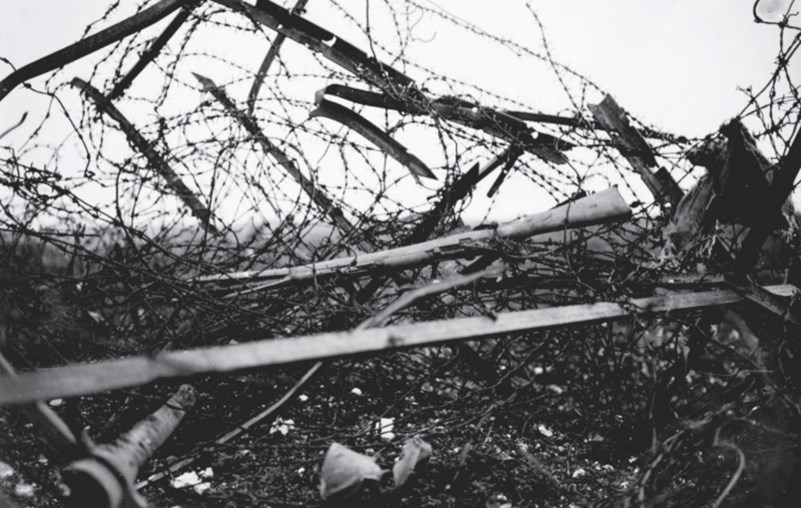
1916 Battle of the Ancre 13 –18 November 1916: A section of the German barbed wire entanglement at Beaucourt–sur–Ancre. IWM Q 4593
The Hand and Rifle Grenade
The Germans and French had truly serviceable hand grenades in 1914, but the British Army’s No, 1 Percussion grenade was a poor competitor, particularly in trench warfare and it was in chronically poor supply. Until a serviceable British model came into full production, truly heroic stopgap measures were required to fill the shortage with home-made devices fabricated both centrally and at the field level. Eventually, by summer 1916, the Mills No. 5 grenade had become standard issue and proved to be a proper match for the 1915 German stick (or cylindrical) grenade. The Mills also provided a solution to the rifle grenade reliability problem. These hand and rifle grenades were designed to produce injury through high explosive blast injuries and laceration wounds from fragments of the grenade casing. Out of these technical advances a specialised fighting unit developed – the Bombing Section – which launched close hand-to-hand fighting missions to either open up the enemy’s positions or to thrust back offensive attacks. In either event, the result was usually numbers of casualties suffering fragmentation wounds and/or blast injuries, often with serious complications and of some complexity.
The Mortar Bomb
In late 1914, a form of weapon that had long been relegated to the collections of military museums came to the fore again due to the needs of trench warfare on the Western Front. This was the short distance/high trajectory mortar bomb that could more readily be used against the trenches, fortifications and dugouts of the Western Front.
As usual, the German military had had the foresight to learn the lessons of more recent wars, such as the Russo-Japanese War of 1904- 05 and made suitable provision for static warfare in an eventual European War. This included an adequate supply of mortars of various calibres and other trench war munitions and equipment. The British had no modern mortars in 1914 and very little in the way of trench war provisions. The French, in extremis, even resorted to the reactivation of ancient siege, garrison and museum mortar pieces. The British made up their deficiencies in mortars by ad hoc devices such as catapults and other crude missile projectors, but these weapons had little impact on the battlefield.
Consequently all sides busied themselves in trying to provide new models of trench mortars. These began to reach the Western Front in large numbers by late 1915. Usually of smooth-bore, these mortars were developed to be deployed in batteries that either hurled a hail of smaller projectiles to smother a defensive position or to break up an infantry charge, or were solitary munitions that lobbed huge mortar shells onto the enemy defence works and fortifications with crushing effect.
Although some of the mortar bombs were so large, ponderous and visible that occasionally limited evasive action could be taken, the smaller projectiles usually arrived out of the blue and exploded in the depths of the trench system.
The random injuries inflicted by the mortar bombs could be due to blast from the high explosive, splinter entry wounds from the casing or crush injuries and asphyxiation from defence structures collapsed by the effect of the mortar bomb.
As the war progressed, the British became increasingly efficient with the trench mortar; the Stokes 3-inch, 4-inch and 6-inch versions being outstanding. Mortar bombs were also subsequently used to deliver toxic gas.
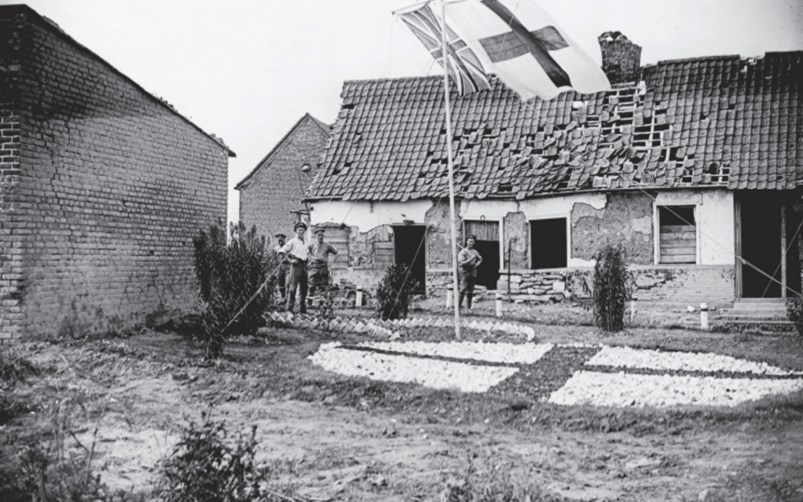
Several soldiers stand outside a dressing station set up in an abandoned house at Ervillers, 17 July 1917. In front of the building, a large red cross has been picked out in red and white stones on the ground and both the Union Jack (sic) and a Red Cross flag can be seen flying from the flag-pole above it. IWM Q 5683.
Armoured vehicles
Armoured cars were deployed on the Western Front from the outbreak of hostilities, but, after the end of 1914, they quickly became largely superfluous in the mud and amid the closely packed trenches and the dangers of no man’s land. However, they were used with some success by Armoured Car Batteries on specific occasions such as during the Battle of Messines in 1917.
In September 1916 the British introduced the tank to the Western Front and, after a slow and operationally disappointing beginning, it had, by the end of the war, established itself as a formidable weapon.
Obviously, an enclosed vehicle stuffed with fuel and explosive munitions presented a considerable hazard to the crew, with the constant risk of instantaneous death, mutilation or serious burns but there were two new hazards that armoured vehicles uniquely presented to their crews. The first was the ‘splash injury’. Even when a missile such as a bullet, shell or shell splinter failed to penetrate the armoured steel plating of a tank, or armoured car, a ‘splash’ of molten metal would often be generated from the interior surface of the plating and ejected into the interior of the armoured vehicle. These splashes could cause all kinds of injuries among the crew from that of a minor nature to one with a serious outcome.
A similar, less serious, but often debilitating injury could be caused in the same way when paint flaked from the interior paint work and showered the inside of the armoured vehicle in the form of shards travelling at high velocity. These shards of paint were particularly dangerous to the crew’s eyes and face and it was quite usual, in the early days of the tank in action, to see the crew leave the crew compartment with blood streaming from multiple minor wounds caused in this way.
Special goggles/face masks and body armour was subsequently provided to alleviate this metal splash and paint shard hazard, but these must have made the already difficult operational conditions in the tank even worse.
In any event, the casualty rate in armoured cars and tanks was always exceptionally high even when compared with the infantry. The tank pioneers were indeed one of the special brotherhoods of the Western Front and suffered many dead and wounded.
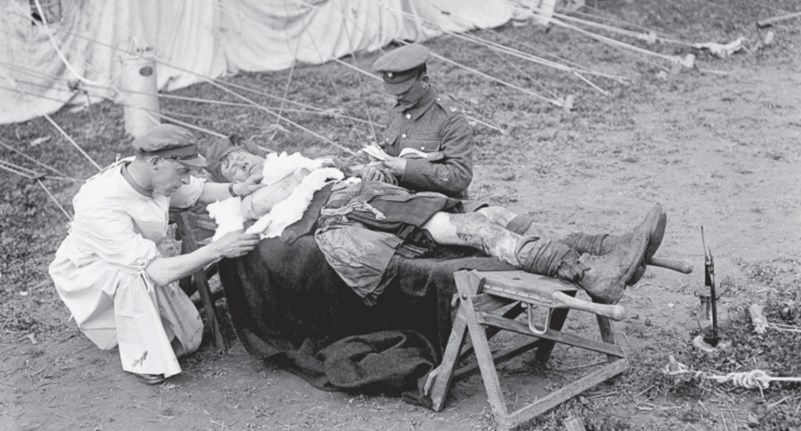
Seriously wounded soldier of the Black Watch receiving basic treatment at a dressing station near Bethune, April, 1918. IWM Q 11577.
The Flame-Thrower
The flammenwerfer – flamethrower - was a German invention introduced on the Western Front against the French near Verdun in February 1915 and on the Eastern Front; but more famously against the British at Hooge in the Ypres Sector in July 1915. The Allies acted quickly to develop their own versions of this apparatus with mixed results.
In principle, it was a terrifying weapon that pumped an ignited mixture of heavy and light, and highly inflammable, fuel oils through a lance for a distance of 50 - 60 yards. The main intention was that the flamethrower would be directed against fortified positions, machine gun nests, dugouts and other concentrations of the enemy. In practice, the use of the flamethrower operationally was compromised by the need to make it highly man portable –carried on a soldier’s back - and the necessity to advance close to the target. The size and shape of the apparatus made the operator(s) exceedingly easy to identify and he/they became an easy target for snipers. Whilst initially much feared by the troops of both sides, it never made the anticipated major tactical impact on the battlefield.
The burn wounds it did cause were truly horrific and it could totally incinerate the human body but it was by no means as effective as the much more deadly napalm based flamethrowers and bombs of later wars.
The incendiary and explosive bullets
Following up upon their limited success in 1916 against German airships and observation balloons with rockets (Prieur), bombs (for example the Hale HE 1lb) and darts (the Ranken 1lb), British aviators decided, despite the banning by the Geneva Conventions of such munitions, to use explosive (Pomery and Brock) and incendiary (Buckingham) bullets for this purpose. The explosive bullet would tear open the canopy and the gasbags containing the highly flammable hydrogen gas that produced the buoyancy of the craft. Then the incendiary bullets would explode the escaping gas, destroying the airship/balloon. These specialist bullets soon became widely used against all kinds of aircraft and became noted for their efficacy.
Obviously, their effect on collateral targets such as human beings was usually devastating and lethal, hence the restrictions imposed on them by the Geneva Conventions.
The Toxic Gas Shell
Once chlorine gas was deployed by the Germans on the Western Front in April 1915, the essential, and limiting, requirement of persistent favourable winds to disperse it towards the Allied trenches quickly became evident, as did the uncertainty of the level of concentration of the gas that would be achieved in the target area. (One thousand parts of chlorine to one million parts air of was the threshold lethal dose). Chlorine gas in the presence of water, as is found in the mucous membranes, is converted to the highly corrosive hydrochloric acid. This produces highly debilitating lesions of the lungs, airways and mucous membranes that are extremely difficult to treat: in fact, in 1914, there was no really effective treatment other than the administration of oxygen to facilitate breathing and routine palliative nursing care.
However, it so happened that the prevailing winds on the Western Front generally blew towards the German trenches; a consideration that the German authorities should have realised was unfavourable to them. All these factors seriously limited the tactical utility of chlorine gas as a weapon of war and to enhance its efficacy it was later used in combination with phosgene, a much more lethal gas.
Accepting the limitations of chlorine and its dispersal, the Germans devised the toxic gas shell with the aim of deploying toxic gases more precisely and at a greater concentration on specific targets. This methodology was particularly suited to the German follow-up toxic gases of phosgene and mustard gas. The latter gas, deployed as a liquid, was particularly effective against exposed skin and mucous membranes: the then available gas masks and protective clothing were only of limited use against it. Shell-case delivered mustard gas could be used to contaminate areas some distance from the German lines and would persist for considerable periods. It also took several days for a soldier to die from mustard gas poisoning causing serious blockages in the casualty clearance system.
The effect of mustard gas on the skin and mucous membranes was, if anything, even more debilitating and refractive to treatment than any other toxic gas. It frequently required a long period of hospitalisation in a special, toxic gas, treatment unit with an even longer period of rehabilitation. Due to the insoluble nature of mustard gas, detoxification was difficult and in the Great War only the hypochlorite bleaches – themselves toxic – were effective in neutralising it. In the longer term, mustard gas was found to be carcinogenic.
Although the overall numbers of toxic gas victims, both injured and fatal, was comparatively small in terms of the total casualties on the Western Front, the effect on morale was dramatic. Also, they took up an unduly large proportion of the available hospital beds and other care facilities; many soldiers were left permanently damaged, to a greater or lesser degree, for life.
Throughout the war the treatment for exposure to toxic gas was rudimentary and was largely of a palliative nature. Accordingly, protective measures were strictly enforced based around ever-improved versions of gas masks and special clothing.
Postscriptum
It will be seen that the Great War became increasingly affected by the belligerent nations’ mastery of the industrial process and the ruthless application of the products of science. War became a continuous 24 hour-a-day marathon in which the combatants became the largely anonymous actors and the detritus, being destroyed in both body and mind on a quite unimaginable scale.
References
This article is based on many sources, primary and secondary, with many of the books now out of print, hard to find outside of the National Archives, or expensive to buy. However, patently the most useful source on this subject is Medical Services, Casualties and Medical Statistics, by T.J. Mitchell and G.M. Smith. 1931 (Reprinted 1997 and published by the Imperial War Museum, London, England and The Battery Press, Nashville, USA. At the time of writing both versions were out of print but copies may still be obtained through specialists such as Abebooks.co.uk as new or second hand.





